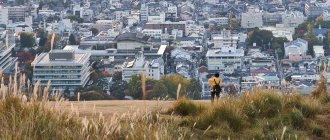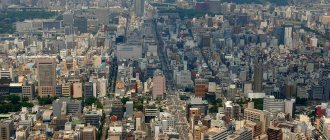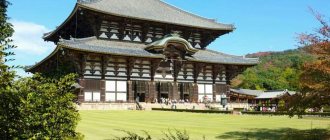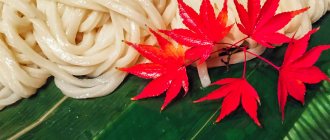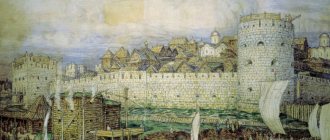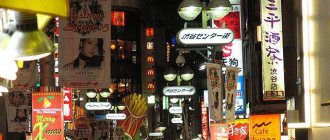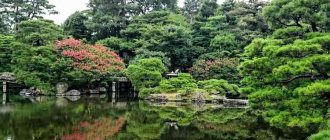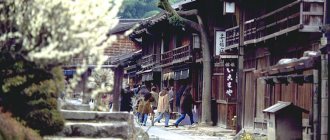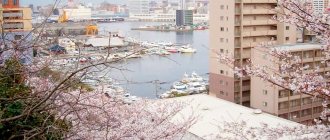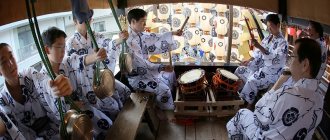Nara Park
The park is rightfully considered the main attraction of the city. On its territory there is a national museum and many architectural sites, including the famous Buddhist temples of Todai-ji, Kofuku-ji and the Shinto shrine of Kasuga-taisha.
The park is famous for its beautiful landscapes and tame deer that roam freely and allow themselves to be petted and fed.
Nara Park and Todai-ji Temple
Located in the very center of the city, Nara Park is a center of history, culture and nature. A highlight of the park is watching roe deer roam the forests and lawns, as well as visiting the many historical buildings, including the magnificent Kofuku-ji Temple. It is located next to the large Sarusawa pond and Uneme Temple. It is noteworthy that Nara Park is the largest and oldest park of its type in Japan. It was founded in the 1300s AD.
Todai-ji Temple, in turn, is one of the most majestic religious buildings in Japan. It was built in the eighth century AD and is the most famous of the seven temples of Nara. Todai-ji Temple is notable for its huge bronze statue of the Great Buddha, cast in Nara in 749 AD, and its large southern gate, Nandaimon. This is a two-story structure on 18 columns with two statues of Nio, whose height is 8 meters. The statues are guardians of the entrance to the temple.
Antibodies to the rescue: one vaccine will be enough for those who have already recovered from COVID
Singer Karina Koks remembered her Wolf costume on “Mask”
WHO recommends vaccination against COVID-19 for mild cases
In addition, there is the Hall of the Great Buddha. This is the largest wooden building in the world. In addition to many other historically significant buildings, the site also features beautiful gardens and water features, including ponds, bridges, and pagodas.
Todai-ji
This is the oldest temple, which is the largest wooden structure in the world. The road to it runs through the Nandaimon gate, guarded by stone demons.
Visitors are amazed by the 15-meter bronze statue of Buddha, as well as the giant columns supporting the arch of the structure. One of them has a special hole called the “Buddha’s nostril”. There is a legend that if a person climbs through it, he will be happy for the rest of his life.
Location: 406-1 Zoshicho.
Yakushi-ji
The monastery was built by order of Emperor Tenmu in 680, whose wife was seriously ill. The wife's miraculous recovery made the monastery popular among pilgrims and those suffering from serious illnesses. Almost all the buildings of the monastery complex were destroyed for various reasons. And only the eastern pagoda has reached us in its original form. Now it is more than 1300 years old. It is considered the oldest wooden building on the planet.
Location: 457 - Nishinokyocho.
Nara, attractions and holy places
Heijo Palace
One of the most remarkable monuments of Japanese and world culture is Heijo Palace , built at the beginning of the 8th century, during the reign of Emperor Genmyo. After this palace, the entire city was called Heijo in the early Middle Ages.
The Suzakumon gate leads to the palace , on both sides of which the entrance is guarded by divine guards Nyo.
Designed in the spirit of Chinese architectural monuments, the palace is one of the examples of the Tempe era (729–766). The spirit of Chinese traditions present in the appearance of this monument is inherent in all early buildings of Nara - the city was built in accordance with a plan that repeated the plan of the then Chinese capital of Chang'an. The monument has survived to this day with significant losses; no more than one third of the once huge complex has survived.
Todaiji Temple
The central place among Nara's sanctuaries is Todaiji Temple (Great Eastern Temple). For a long time it was the main state shrine of the country. Its construction dates back to the middle of the 8th century, when Buddhism, which had penetrated into Japan two centuries earlier, had already become the state religion and had a significant influence on the art and architecture of this country.
Also interesting: Shogun city Kamakura, the ancient capital of Japan
The temple was built according to a vow by Emperor Semu (reigned 724-749) in the then capital of Nara. It was consecrated in 752. Todaiji acted as a symbol of statehood; state ceremonies of a non-Buddhist nature took place there (for example, the ceremony for awarding official ranks).
Todaiji Temple is widely known for its bronze sculpture of Dainichi Buddha (Daibutsu) , which is the largest Buddha statue in Japan and one of the largest in the world. It was sculpted in 749 by a Korean sculptor, whom the Japanese call Kimimaro. To make the giant statue, it took 437 tons of bronze, 150 kg of gold, 7 tons of wax, 70 kg of mercury and several thousand tons of charcoal.
The Great Buddha statue at Todaiji represents "blessing, omnipotence and omnipresence." Buddha sits with his legs tucked under him in a peaceful pose on a throne in the form of a colossal blossoming lotus flower with 56 petals. The lotus appears here as a symbol of spiritual chastity, purity and purity necessary for immersion in nirvana, achieving bliss achieved as a result of overcoming “passion and thirst for life.” The Buddha's right hand, palm open, is extended forward in a blessing gesture. Buddha's hair is blue - this symbolizes his stay in the transcendental heavenly world. The hair is divided into 966 curls. There is a huge bump on the forehead: a symbol of greatness and inaccessibility.
The Great Buddha is one of Japan's most famous landmarks. The height of the statue with a pedestal is 22 m. The height of the seated Buddha figure is 16 m. The face is 5 m long and 3 m wide. A person can freely crawl through the eye sockets - their length is 1 m. The diameter of the lotus throne is more than 20 m, the height of each petal is 3 m.
The hall of Todaiji Temple, in which the Buddha sculpture is located, is called Daibutsuden - Hall of the Great Buddha . Todaiji was once the main temple of the Kegon Buddhist sect, whose teachings in the 8th century. entered Japan from China. Construction of Todaiji Temple began at the turn of the 20s and 30s. VIII century and lasted twenty years. It was declared a national affair, requiring the mobilization of all the country's resources. The temple was consecrated in 752 in the presence of the emperor and empress, the court, clergy and representatives of all the provinces of Japan, as well as embassies from China and Korea.
Also interesting: Edinburgh Castle, the architectural symbol of Scotland
In the 12th century, during the civil war, the huge temple burned down. During the fire, the Buddha's head was damaged and had to be replaced with a new one. Today you can notice that the Buddha's head is a darker color than his torso. According to other sources, the entire Buddha sculpture was badly damaged by a fire and many of its elements were replaced in the 18th century, so it cannot be considered entirely authentic.
In 1567, the temple burned down again, and the Great Buddha stood in the open air for more than a hundred years. Only in 1699 did restoration work begin, but three years later, having only half built the temple, construction was abandoned again. In this form it stood for about two hundred years and as a result completely collapsed. Construction was resumed only in 1903 and lasted ten years. By 1913, the temple was restored to its original form. Its height is 50 m, length - about 57 m, width - more than 50 m. This is the largest wooden building in the world, and for its time it was simply a miracle of construction art.
The walled temple can be entered through the Great Southern Gate - Nandaimon , with a two-tiered roof and five bays, which were rebuilt in 1199 and supported by eighteen wooden columns. Whole trunks of giant trees 21 m high were used as columns.
On both sides of the gate tower colossal statues of the fantastic guardian monsters Nyo. The massive entrance doors of Todaiji Temple are designed in the ancient style of Japanese temple architecture. A monumental arch above the entrance under a hipped roof with curves characteristic of Japanese architecture gives the building solemnity and majesty. The walls of the temple are decorated with magnificent wooden carved reliefs, lacquer painting, and enamel, executed with truly Japanese taste and perfection of form.
A huge bronze bell weighing 48 tons is installed nearby. It was cast about 1200 years ago. The sound of this bell lasts about 2 minutes.
Kasuga Taisha Shrine
Among other monuments in Nara, the Kasuga Taisha Shrine, which occupies an important place in the spiritual life of the Japanese, is very famous. It is often visited by the imperial family, many holidays are held here, and traditional performances of ceremonial music and dances of ancient Japan take place.
Kasuga Taisha Shrine was built in 768, but was subsequently destroyed and rebuilt several times. The temple is painted in traditional bright red color.
Also interesting: Castles of the Loire, part 15: Cheverny, a palace worthy of kings
Apart from being a pilgrimage site, Kasuga Taisha Shrine attracts many tourists thanks to its countless lanterns. They were presented to the temple as donations from all over the country. You can see them lit only twice a year - during the Shotsubun holiday (February 2-4) and during the Obon holiday (August 15-16).
Yakushi-ji Temple
Yakushi-ji is an ancient Buddhist temple in the Japanese city of Nara. The temple is represented by the Japanese Hosso tradition, and is famous for its sculpted Yakushi trinity, which includes the Buddha of Medicine (Yakushi-nerai), as well as the bodhisattvas Chandraprabhu and Suryaprabhu, represented as deities of solar (Nikko) and moonlight (Gakko) light.
Buddha Yakushi-Nyorai is depicted seated on a throne against the backdrop of a magnificent relief halo. The height of the statue, cast with unprecedented skill in 678–685, is 2.5 m. Yakushi-ji is included in the list of the seven largest temples in southern Japan.
Yakushi-ji was founded in the city of Kashihara in 680 by Emperor Tenmu, but construction was delayed and the emperor eventually died. Beginning in 697, a statue of Yakushi-nerai was installed in the temple, and the temple was completed. In 710, it was decided to move the temple to the city of Nara. The process lasted 8 years, and in 718 the shrine was moved.
The complete temple complex consists of the Kondo main hall, Kodo lecture hall, Western and Eastern pagodas. The structure of the shrine symbolizes the Buddhist paradise on earth.
Yakushi-ji survived fires and natural disasters several times. They only miraculously did not affect the Eastern Pagoda, which is one of the oldest wooden buildings on the planet. On the walls of the temple you can see paintings telling about the travels of the monk Xuanzang. The shrine was built in traditional Japanese style.
The monuments of Nara testify to the developments that took place in the 7th–8th centuries. traditions of Japanese art, which developed in subsequent centuries.
Gango-ji
The once grandiose structure, consisting of 7 halls and pagodas, has survived to this day in the form of several buildings. Of these, the best preserved are the Zen room, the main hall of Hondo and the miniature pagoda, whose height is just over 5 meters. All listed objects are included in the list of National Treasures.
Location: .
Saidai-ji
Previously, the complex occupied an area of about 50 hectares and consisted of more than 100 buildings, of which only a few have survived. It gained popularity among residents and tourists thanks to its unique tea ceremony. Anyone can take part in the tea party. Its peculiarity is that tea is served in huge cups weighing up to 7 kg.
Tosedai-ji Temple
Founded in 759, Tosedai-ji was built as the main of the 30 temples of the Risshu sect. While only two of the original buildings remain, the main and lecture halls retain much of their original layout and are a real treat for history buffs.
The main hall of Kondo is the largest and finest example of tempeh style architecture remaining in Japan. It is famous for its vast columned gallery and the large seated statue of Rushana-Butsu with a magnificent halo decorated with 864 small Buddhas. The Kodo Lecture Hall is also worth exploring. It contains many fine sculptures, including a number carved from a single piece of cypress wood.
Infectious disease specialist noted increased infectiousness of the new strain of coronavirus for children
Work has begun on an open world game based on Star Wars
Miners began making farms from gaming laptops: up to $70 thousand in profit per year
Other notable buildings are the Higashimuro priestly quarters, the cult hall of Raido and the Koro drum tower, where the Uchiwa-Maki festival is celebrated every May.
Horyu-ji
The religious complex is a 12-minute drive from the city. Like all the Seven Great Temples, it is filled with an atmosphere of oriental originality. Its main value is that almost all the buildings have reached us in their original form. Unlike its six brothers, the structure gives the impression of an airy and light structure.
Location: 1-1 Horyuji Sannai, Ikoma District.
Story
Nara is the first permanent capital of Japan, founded in 710. Heijo Palace became the home of the emperor. Until 710, the capital was moved to a new location whenever a new emperor ascended the throne.
Nara was not destined to be the main city of Japan for long. The influence and political ambitions of powerful Buddhist monasteries became a serious threat to the government, and in 784 the emperor's residence was moved from Nara to Nagaoka, and a few years later to Kyoto.
The city is less than an hour's drive from Osaka. Thanks to its past as the first permanent capital, it is still full of historical treasures, including some of Japan's oldest temples.
Kasuga-taisha
A Shinto shrine whose main buildings are painted bright red. A special feature of this historical monument is the huge number of different lanterns located on its territory. They are lit during two holidays in February and August. Next door is the beautiful Manyoshu Botanical Garden.
Location: 160 - Kasuganocho.
National Museum
This is one of the oldest museums in the country. The main exhibitions are dedicated to Japanese art. The exhibits include statues of gods, paintings, manuscripts, and bronze vessels. In 1980, a library of Buddhist art was opened in one of the premises.
You should definitely visit the underground corridor connecting the East and West wings of the museum, and the tea house located in the courtyard.
Isuen Garden
Isuen Garden, home to the small but interesting Neiraku Art Museum, opened in 1969 and is designed in the famous Japanese shakkei style, which literally means “borrowed landscape.”
“She lets my husband and I have a light”: Kravets is thinking about sending his daughter to a boarding school
Less is better than more: why it is important to monitor the amount of vitamins you take
Meghan Markle is expecting her second child. There will be a new addition to the prince's family
The most famous attractions of this place are the three tea houses in the near part of the garden. They are called Seishuan, Sanshutei and Hexintei. The last house is famous for its excellent green tea. Also worth a visit is the Teishuken Lounge. The older rear part of the garden, laid out in 1899, has the south gate of Todaiji and Mount Wakakusa as a backdrop, and on an island in a small lake is the foundation stone of the Buddha Hall, while the steps are old millstones used in the production of dyes for fabrics.
Isuyen Garden
The traditional Japanese style garden is located in Nara Park. It occupies an area of more than 13 thousand m2, on which several picturesque reservoirs are located among lush greenery.
On two islands in the central pond there are figures of a turtle and a crane, which are considered symbols of Japanese longevity. The garden paths lead to wonderful tea houses. Since 1969, the Museum of Ceramics has been operating on its territory, the collection of which includes more than 2 thousand exhibits.
Kofuku-ji Temple
Another of Nara's seven majestic temples, also located in Nara Park, the Kofuku-ji temple complex consisted of 175 buildings in its heyday. Among the surviving structures built in 669 AD is the octagonal Nan-Endo Hall, built as early as 813. This hall contains a statue of Fukukenjaku-Kannon, which was carved and installed in 1188.
In addition, this hall houses very beautiful statues of the Four Heavenly Guardians and the Six Patriarchs of the Hosso Sect. In front of the hall is a ninth-century bronze lantern with an inscription attributed to Kobo Daishi, as well as a three-story pagoda. Another notable building of this temple is the northern hall of Hoku-Endo, built for Empress Genso in 721 AD. In this hall there is a statue of Yakushi-Nyorai, made in the 15th century.
